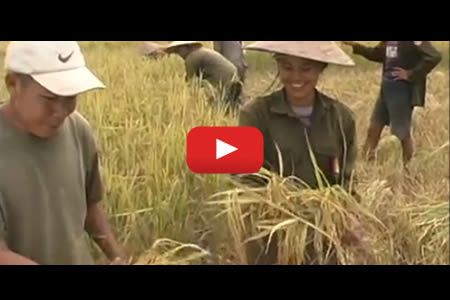Direct seeding
Direct seeded crops require less labor and tend to mature faster than transplanted crops.
In this method, plants are not subjected to stresses such as being pulled from the soil and re-establishing fine rootlets. However, they have more competition from weeds.
Depending on the land preparation method used, direct seeding can be done in two ways:
Dry direct seeding
This method is usually practiced for rainfed and deepwater ecosystems. Farmers sow onto dry soil surface, then incorporates the seed either by plowing or harrowing.
- Broadcasting

- Broadcast 60−80 kg of seeds uniformly by hand or in furrows in 1 ha of field.
- Make shallow furrows by passing a furrower along the prepared field.
- After broadcasting, cover the seeds using a spike-tooth harrow.
- Drilling
Precision equipment, such as the Turbo Happy Seeder, can be used to drill seeds.
Drill 80−100 kg of seeds per ha.
Seeds are placed by the machine into both dry and moist soil, and then irrigated. A smooth, level seedbed is necessary to ensure that seeds are not planted at depths greater than 10−15 mm.
In this technique, fertilizers can be applied at the same time as the seed. Manual weeding also is easier in machine-drilled crops than in broadcast crops.
- Dibbling
Dibbling or hill planting is usually practiced along mountain slopes or where plowing and harrowing are difficult.
- Use a long wood or bamboo pole with a metal scoop attached at the end for digging holes.
- Drop the seeds into the holes and cover them with soil.
Direct seeded rice have more competition from weeds. Weeds can be controlled through the following:

 Drum seeding
Drum seeding








